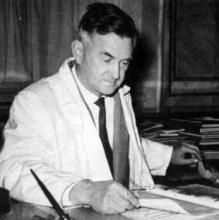Oleg Konstantinovich Antonov (25.01.(07.02)1906, in Troitsa. Moscow region, Russian Federation - 04.04.1984, Kyiv; has been buried in the Baikove Cemetery.) – was a prominent Soviet aircraftdesigner. Academician of the Academy of Science of the USSR (1981)the Academy of Science of the Ukrainian SSR(1967), a Doctor of Science(1960), Honored Scientist of the USSR (1976), received Lenin Award(1962), USSR State Prize (1976), Hero of Socialist Labor (1966).
He was born on 7 February 1906 in Troitsy (now Troitske village, Moscow region, Russia), in a family of the civil engineer. After graduating from of the Saratov labor school (1922) he worked as the designer of gliders of "Organization of Friends of the Air Force" where he constructed the first gliders of own design. The glider "Pigeon" (1924) is noted by the diploma for originality on the 2nd All-Union meeting of glider pilots in the Crimea. Since 1925 he studied at the Leningrad polytechnical institute. In 1926 he design the glider ‘OKA-2’. After graduation in 1930 he was sent to Moscow for the organization of the Central bureau of glider designs and adjustment of their mass production. in 1931 Antonov became the chief designer at the Moscow in which he designed 30 different gliders, mainly for initial preparation of flight shots (among them - glider "Rot Front 7", which in 1939 set a world distance record - 749 km).
During World War II, Antonov designed the A-7 military glider used for airbridge supply of the Soviet partisans behind the front lines (for transportation of equipment, fighting equipment, staff) a towing glider biplane of A-40 (for transportation in air of an armored vehicle), widely-used for support of the guerrilla movement. In 1943-1945 Oleg Konstantinovich become the deputy chief designer A. Yakovlev, worked on creation and improvement of the ‘Yak’ fighters. Since May, 1946 A. Antonov headed new aircraft constructing design office in Novosibirsk where in August, 1947 the multi-purpose An-2 plane was designed. Conceived as agricultural, An-2 quickly became multi-purpose, received 16 modifications and got 40 professions. An-2 licenses issued by the Chinese and Polish aircraft. Concurrently in 1948-1950 he headed the Siberian Research Institute of Aviation. In 1952 Alexander Antonov’s Design Bureau moved to Kyiv, where it began to specialize in developing gas turbine passenger and military transport aircraft. Since 1952 Oleg Konstantinovich was the main designer, since 1962 was the general designer, the head of CB of aircraft construction in Kiev (nowadays Aviation scientific and technical complex of O. K. Antonov). Pluralitically since 1977 he worked as the manager of chair of planes of the Kharkov aviation institute.
Personally A. Antonov and under his management executed more than 50 design development of gliders and planes of various class and appointment. Within the 1950th years of CB of Antonov the multi-purpose plane of short take off and landing of An-14, passenger AH-10 (in the mid-sixties - the champion by number of the transported passengers, freights and mail on one plane in a year in the USSR) and transport AH-12 is designed and constructed. In 1960-1970 under the leadership of A. Antonov the passenger An-24 plane adapted for flights from soil airfields of local air-lines (it was exported to 26 countries of the world), In 1960-1970 under the leadership of A. Antonov the passenger An-24 plane adapted for flights from soil airfields of local air-lines (it was exported to 26 countries of the world), the first-ever widebody transport plane for distant air transport of heavy large-size freights and equipment An-22 by "Antya" on which it is established 41 world aviation records is started in production, and also jet AH-72 for operation in airfields with a limited length of a strip is created. The last development of A. Antonov is the largest transport Ruslan An-124 plane for the time calculated on transportation of a payload in 150 tons on distance of 4500 km with a speed of 850 km/h (on it 22 records are set).
He combined intense scientific and design activity with political activity. The deputy of 8-11 convocations of the Supreme Council of the USSR, in November, 1965 he signed the open letter in the Central Committee of CPSU (the so-called letter of the 78) with a protest against political repressions concerning representatives of the creative intellectuals of USSR and discrimination of the Ukrainian literature.
1999 for outstanding achievements in creation of planes the name of A. Antonov is brought in International a space hall of Fame of the Space museum (. San Diego, piece California, USA).

